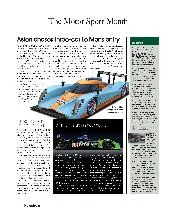
Aston chases three-car Le Mans entry
Aston Martin Racing could field as many as three Gulf-liveried LMP1 prototypes in the Le Mans 24 Hours. AMR, which is run by Aston chairman David Richards’ Prodrive company, revealed…

Prior to touring cars, Andy Priaulx was dominant in the 1999 Renault Spider Series, winning every race
The Renault Sport Spider is a curious thing. A quirky- looking two-seater racing car for the road, it was designed to boost Renault’s sporting image on the back of success in Formula 1. It had everything going for it: financial backing, one of the biggest names in motor racing in the technical department and a single-make race series on the racecard of the British Touring Car Championship. Yet it turned out to be a rather glorious failure.
Over its three-year lifespan fewer than 1700 road cars were built – all by hand at Alpine’s Dieppe plant – with only 100 right- hand-drive versions being made for the UK.
So total failure, then? Well, not quite, because it was actually rather brilliant, just more than a little misunderstood.
The Spider should have made all the sense in the world at the time. Remember, it’s the early 1990s, and Williams-Renault is the dominant force in Formula 1, with Nigel Mansell, Alain Prost, Damon Hill and Jacques Villeneuve capturing four world championships in six years for Frank Williams’ team, and Michael Schumacher making it five from six for Renault with his Benetton victory in 1995. Yet for all its sporting success, Renault’s road-car range consisted of less-than-thrilling family saloons and people carriers, and the odd spicy Clio. There was definitely scope to try something new, and Renault at the time wasn’t shy of doing so. Remember the bonkers 800bhp Espace F1 of 1995, which had the 3.5-litre, 40-valve V10 engine of Prost’s Williams FW14?
Renault needed something light, nippy and radical in its range, so it set about designing a new sports car for both road and track, with a single-make race series in mind for promotion from the start.
Codenamed Project W94, Renault began from scratch, creating an all-aluminium chassis in the Alpine factory, wrapped it in plastic bodywork, with no roof and, if you were anywhere but the UK, no windscreen either. European cars never got a screen and had to make do with the strange spoiler-like aeroscreen that also featured on the race cars.
Into the new chassis went the 150bhp four-cylinder 2-litre F7R engine from the Clio Williams. When Renault unveiled the Spider at the 1995 Geneva Motor Show it caused more than a little excitement. It looked like nothing else on the road, featured scissor doors, and weighing just 930kg proved as quick as stink, yet made impression in the showrooms.

Trophy-spec Spiders at Silverstone
Sadly for Renault, the hardcore Spider was released right into the path of Lotus’ first – and considerably better equipped – Elise. The British car was fast and light, and with a price tag starting at £19,000 – £6000 less than the Spider – it was within the reach of the average car enthusiast. More than 10,000 were sold. The Elise grabbed all the attention, along with every award going, to consign the little plastic Renault to niche curio at best.
But the one area where the Spider did excel was on the racetrack. Renault produced just 80 Trophy cars in total and threw its weight behind the single-make Renault Spider Series, most notably in the UK.
Williams breathed more on the engine to find 210bhp and added a six-speed Sadev sequential gearbox. The chassis benefited from a roll cage and was trimmed back to 850kg. Thanks to Renault’s clout, the package went straight onto the BTCC racecard for 1996.
Some stellar names came through it, too. Jason Plato collared the inaugural championship, topping the podium in 11 out of 14 races a year before being promoted to Renault’s Williams-run Laguna BTCC team. Andy Priaulx went even better in 1999, completing a whitewash of 13 wins from 13, each from pole and with fastest lap in all but two.
The Spider Trophy was canned for the turn of the Millennium to be replaced by the returning Renault Clio Cup. However, if you’re lucky enough to find a Spider Trophy in good condition, it’ll likely have great investment potential.